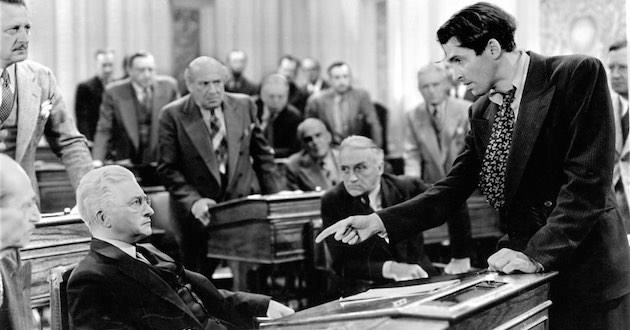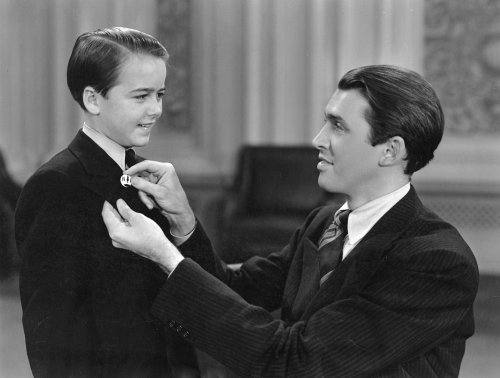Who hasn’t heard of the movie “Mr. Smith Goes to Washington”? Everyone should see this movie. What I discovered via a little research was that iconic film director Frank Capra and iconic American painter Norman Rockwell are basically two sides of the same coin. And that the coin could arguably be labeled as propaganda, since the government at one point funded some of Capra’s work.
Their art had largely to do with elevating World War II draftee morale by establishing enough pride in our hallowed American way of life to motivate young men to go fight the Nazis and safeguard our American freedoms. Capra and Rockwell are the movie and painting equivalents of the rosy glow of country house wood-burning stoves in midwinter dusk, reflecting off the smiley faces, carrot noses, and corncob pipes of neighborhood frosty snowmen.
Starring: James Stewart, Jean Arthur, Claude Rains, Edward Arnold, Guy Kibbee, Thomas Mitchell, Beulah Bondi, Astrid Allwyn
Rating: Not Rated, Running time: 2 hours, 9 minutes
Release Date: Oct. 19, 1939
Rated: 4 stars out of 5
Rockwell’s work, regardless of the fact that he was a master draftsman, was always considered “cutesy,” and Capra’s movies were often derided as “Capra-corn.” And yet, they summed up — better than anyone before or since — the folksy essence and upright values the founding fathers bequeathed to America.
The Story of Mr. Smith
The supremely patriotic, small-town, idealistic, and spectacularly green Jefferson Smith (James Stewart), leader of the Boy Rangers, is appointed as junior senator because of his unparalleled (and therefore useful) naiveté, by his state’s senior senator Joseph Paine (Claude Rains). Young Smith is to fill the unexpired term of a recently deceased senator.
It turns out that Senator Paine, a presidential hopeful, is also a childhood friend of Jefferson Smith’s dad, and a hero to Smith. Paine shamelessly uses this emotional leverage to sway Smith, who is the very definition of a patsy, to come to Washington.
In Washington, Smith is initially swept away by the shock and awe of seeing the Capitol dome shining in the middle distance, the engraved prose on hallowed marble architecture espousing high morals, and the aching solemnity of Arlington Cemetery. He feels worshipful in the presence of the Lincoln Memorial.
Soon, however, he begins to get a whiff of the reek of corruption, and the many shortcomings of the political process, as the machinations of Joseph Paine and Paine’s business boss, Jim Taylor (Edward Arnold), become increasingly clear.
Paine and Taylor are attempting some sneakiness, which is why they highly appreciate Smith’s guilelessness. He’s not experienced enough and is too idealistic to be able to recognize the graft clause in the bill that Senator Paine is attempting to sneak into law.
Then Clarissa Saunders, Smith’s highly cynical, seen-it-all, knows-the-law-better-than-the-lawyers, wisecracking secretary (Jean Arthur), takes pity on Smith’s haplessness with what appears to be an atrophied mothering instinct triggered by Smith’s boundless innocence. She schools him in the real-life, low-life operations that go on in Washington.
Smith, now wise to Taylor and Paine’s dirty-deeds-done-dirt-cheap, is of course, in true Jimmy Stewart fashion (“This is what we cast him for!”) not having any of it, whereupon the two older men and their minions immediately seek Smith’s political demise. They try framing him via scandal, using forged signatures, character assassination, and perjuring witnesses. Smith is thus eventually pronounced by a Senate committee as not being worthy to continue to hold his seat.
But now, that fire of righteousness that lived inside Jimmy Stewart starts to shine. Smith won’t back down: When the senators turn a deaf ear, Smith, coached by a nail-biting Saunders, exercises his constitutional right, and filibusters up a storm, holding the floor for 23 harrowing hours.
This epic, constitutional battle of a lone man against the Senate is fantastic, but it’s marred somewhat by an 11th-hour, deus ex machina, moral about-face by Senator Paine, who apparently intuited the ring of hell he’d be descending to had his Machiavellian schemes managed to bear fruit.
The Takeaways
There are many uplifting takeaways; for one, the notion that lost causes are the only causes worth fighting for.
Many will now find “Mr. Smith Goes to Washington” ridiculously dated and sappy. In today’s world, an idealistic individual such as young Smith — one who learned Lincoln’s speeches by heart and believed in them — would get laughed out of town. Not only do we, entrenched in our current cynicism, not know Lincoln’s speeches by heart, but neither do we believe in any way, shape, or form, let alone from the bottom of our hearts, that the exalted men, grand speeches, and soaring architecture were originally meant solely for the good of mankind.
The greatest takeaway from this venerable American film, for me, is the tragic scene of honest, kind Jefferson ridiculed and run out of town on a rail, sitting among his luggage in the train station, weeping for the loss of his innocence. The devastation of lost ideals and belief in the fundamental goodness of one’s fellow man depicted here is worth its weight in gold, and Jimmy Stewart nails that loss for us.
Equally powerful, but in a restorative, nurturing sense, is Saunders coming to his rescue. For Smith, unwittingly, has done that thing so brilliantly articulated in the 2000 movie “The Tao of Steve” regarding the causes of romantic attraction: Jefferson Smith has “Done a great thing in her presence.” She has witnessed the rare, brilliant light of Smith’s inner commitment to doing good. And fell in love with it.
Finding him thusly emotionally destroyed, she builds him up again, reminding him that Lincoln himself had to fight against his myriad detractors. She makes him believe in himself — by believing in him — and helps him locate his “never quit” inner warrior, his inner hero, and coaxes him to hew to it.
It’s a long, lonely fight, that filibuster version of “Hell Week” coming up ahead of them, but she spurs him to fight that good fight no matter what, and gives him the coziness of her love, commitment, and ace-in-the-hole insider knowledge of what he needs to do to win. She preserves his faith (and through him, ours) in democracy. Very inspiring.
“Mr. Smith Goes to Washington” offended senators when it was released; they thought it characterized the Senate as corrupt and populated by thieves. But as unpopular as it was with the political crowd, it did good at the box office, got good reviews, and was nominated for 11 Academy Awards.
–MarkJackson | EPTimes










